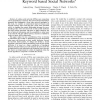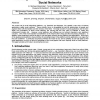CSE
2009
IEEE
14 years 6 months ago
2009
IEEE
— Advanced communication technologies enable strangers to work together on the same tasks or projects in virtual environments. Understanding the formation of taskoriented groups ...
CSE
2009
IEEE
14 years 6 months ago
2009
IEEE
CSE
2009
IEEE
14 years 6 months ago
2009
IEEE
—In online social networks (OSNs), user connections can be represented as a network. The network formed has distinct properties that distinguish it from other network topologies....
CSE
2009
IEEE
14 years 6 months ago
2009
IEEE
— We study how an online community perceives the relative quality of its own user-contributed content, which has important implications for the successful self-regulation and gro...
CSE
2009
IEEE
14 years 6 months ago
2009
IEEE
—The hidden knowledge in social networks data can be regarded as an important resource for criminal investigations which can help finding the structure and organization of a crim...
CSE
2009
IEEE
14 years 6 months ago
2009
IEEE
—The success of a Public Key Infrastructure such as the Web of Trust (WoT) heavily depends on its ability to ensure that public keys are used by their legitimate owners, thereby ...
CSE
2009
IEEE
14 years 6 months ago
2009
IEEE
—This paper presents a model of collaborative decision-making for groups that involve people and computer agents. The model distinguishes between actions relating to participants...
CSE
2009
IEEE
14 years 6 months ago
2009
IEEE
—Due to the exponential growth of information on the Web, Recommender Systems have been developed to generate suggestions to help users overcome information overload and sift thr...
CSE
2009
IEEE
14 years 6 months ago
2009
IEEE
—The recently developed small wireless devices ranging from sensor boards to mobile phones provide a timely opportunity to gather unique data sets on complex human interactions, ...
CSE
2009
IEEE
14 years 6 months ago
2009
IEEE
The current set of social networking platforms, e.g. Facebook and MySpace, has created a new class of Internet applications called social software. These systems focus on leveragi...



